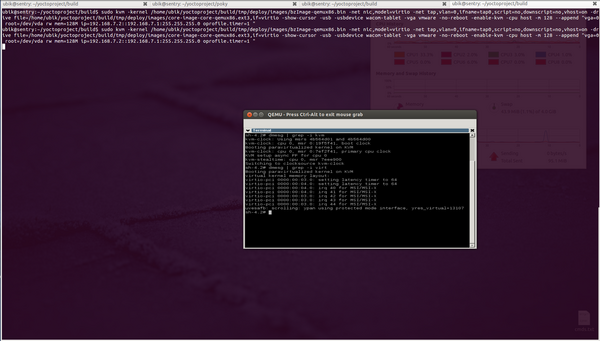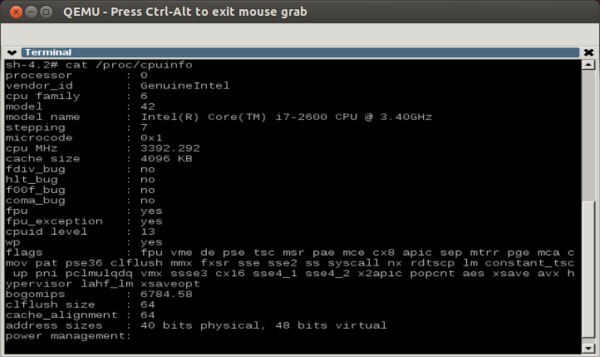Running an x86 Yocto Linux image under QEMU KVM
Host OS preparation (VM manager host OS)
1.Enable KVM on the host machine
2. Enable on host OS vhost-net virtio networking accelerator to mitigate overhead on QEMU virtualization environment.
Load vhost-net module on KVM Host.
[root@dlp ~]#modprobe vhost_net [root@dlp ~]#lsmod | grep vhost
The result of running the commands should be similar to the following:
vhost_net 24241 0 macvtap 7867 1 vhost_net tun16825 3 vhost_net
Basically, follow the same guide as for enabling KVM on the host (step 1.), but replace kvm with vhost_net
3. Start the VM using the line below:
ubik@sentry:~/yoctoproject/build$ sudo kvm -kernel /home/ubik/yoctoproject/build/tmp/deploy/images/bzImage-qemux86.bin -net nic,model=virtio -net \
tap,vlan=0,ifname=tap0,script=no,downscript=no,vhost=on -drive file=/home/ubik/yoctoproject/build/tmp/deploy/images/core-image-core-qemux86.ext3,if=virtio \
-show-cursor -usb - usbdevice wacom-tablet -vga vmware -no-reboot -enable-kvm -cpu host -m 128 --append "vga=0 root=/dev/vda rw mem=128M \
ip=192.168.7.2::192.168.7.1:255.255.255.0 oprofile.timer=1 "
This is an example of running a virtualized Yocto image, with KVM active, cpu host features exported in the Yocto VM, paravirtualization enabled, and using virtio interfaces for disk access and networking. On a machine equipped with a Core i7 2600 (3.4GHz, 4 cores, 8 threads)/8 GB RAM/Intel SSD G3 120GB qemux86 Yocto Linux boots in around 7 seconds for a core-image-x11. The same image boots in 20 seconds without virtualization optimizations and feels slower in usage.
See the following screenshots:
Guest OS preparation
The following kernel configs needs to be enabled for Yocto Linux guest OS:
[...] CONFIG_PARAVIRT_GUEST=y CONFIG_KVM_CLOCK=y CONFIG_KVM_GUEST=y CONFIG_PARAVIRT=y CONFIG_PARAVIRT_CLOCK=y CONFIG_VIRTIO_MMIO=y [..]

